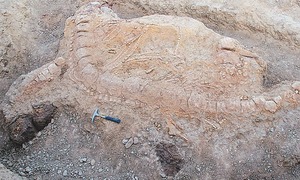 It took more than 10 years of painstaking work, grinding an
Australian rock containing fossils smaller than the eye could see, to
confirm the earliest direct evidence of life on Earth, scientists said
on Monday.
It took more than 10 years of painstaking work, grinding an
Australian rock containing fossils smaller than the eye could see, to
confirm the earliest direct evidence of life on Earth, scientists said
on Monday.
The 3.5-billion-year-old fossils — many
narrower than a human hair — are described in the Proceedings of the
National Academy of Sciences, a peer-reviewed United States journal.
Other teams of scientists have reported even earlier signs of fossil life, going back 3.95 billion years.
But those studies are based on either an apparent shape of a microfossil, or a chemical trace — not both.
“None
of these studies are regarded as proof of life,” lead author John
Valley, professor of geoscience at the University of Wisconsin-Madison,
told AFP. “This is the first, oldest place where we have both morphology and the chemical fingerprint of life.”
Eleven kinds of microbes, preserved in both their cylindrical or snake-like structures, are preserved in the rock.
Some of the bacteria are now extinct, while others are similar to contemporary microbes.
The tiny fossils were found in 1982 from the Apex chert deposit of Western Australia.
Two scientific papers were published on the rock's apparent microbial contents — one in 1993 and another in 2002.
But
critics raised questions, suggesting instead they were not life but odd
minerals that merely looked like biological specimens.
So Valley and his fellow researchers spent a decade developing a technique to tease apart the contents of the fossils.
Researchers
at the University of Wisconsin-Madison modified a tool, called a
secondary ion mass spectrometer (SIMS), to grind down the original
sample one micrometer at a time, without destroying the fossils which
were “suspended at different levels within the rock and encased in a
hard layer of quartz,” said the report.
“Each microfossil is about 10 micrometers wide; eight of them could fit along the width of a human hair.”
The
technique allowed scientists to detect ratios of carbon-12 from the
carbon-13 within each fossil, and compare them to a section of the rock
which had no fossils.
“The differences in carbon isotope
ratios correlate with their shapes,” Valley explained. “If they're not
biological there is no reason for such a correlation.”
Some
of the microbial life inside is believed to have relied on the Sun to
produce energy, while others consumed methane, which was a big part of
Earth's early atmosphere before oxygen.
“This was a well-developed microbial community,” Valley said.
Hunt for first life
The hunt for the first evidence of life is all-consuming for
some scientists, eager to pinpoint the earliest signs after the Earth
formed some 4.6 billion years ago.
Microbial life likely
began as far back as 4.3 billion years ago, said co-author William
Schopf, professor of paleobiology at the University of California, Los
Angeles (UCLA).
The existence of several different kinds
of microbes 3.5 billion years ago shows that “life had to have begun
substantially earlier — nobody knows how much earlier — and confirms it
is not difficult for primitive life to form and to evolve into more
advanced microorganisms,” he said.
A separate study
published in September in the journal Nature said researchers had found
3.95 billion-year-old chemical traces of life in Canadian rocks.
However, that study — which proclaimed the oldest evidence of life on Earth — also raised scepticism.
One
of those critics, Martin Whitehouse, a geologist at the Swedish Museum
of Natural History in Stockholm, said the PNAS report appears to be “a
sound study.”
“Regarding the Canadian study, the main
differences are (a) these new findings are actual fossils preserving
morphology, not just blobs of graphite,” he told AFP in an
email. “And (b) the geochronological interpretation of the Canadian
example is, in my opinion, fundamentally flawed, whereas here the dating
is unambiguous.”
Researchers hope their technique can
one day be applied to other microfossils, perhaps even those that come
from cosmic bodies beyond Earth.